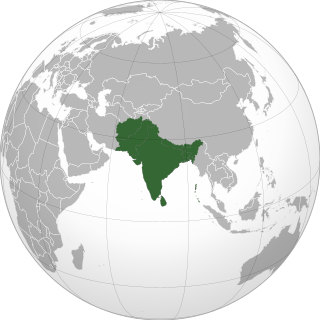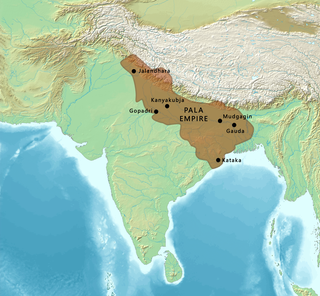
The middle kingdoms of India were the political entities in the Indian subcontinent from 230 BCE to 1206 CE. The period begins after the decline of the Maurya Empire and the corresponding rise of the Satavahana dynasty, starting with Simuka, from 230 BCE. The "middle" period lasted for almost 1436 years and ended in 1206 CE, with the rise of the Delhi Sultanate, founded in 1206, and the end of the Later Cholas.

Kannauj is an ancient city, administrative headquarters and a municipal board or Nagar Palika Parishad in Kannauj district in the Indian state of Uttar Pradesh. The city's name is an evolved form of the classical name Kanyakubja. During the ancient Vedic period, it was the capital city of the Panchala Kingdom during the reign of king Vajrayudha. In the medieval era, it formed the core of the Kingdom of Kannauj and was ruled by multiple successive royal families.

The Pratihara dynasty, also called the Gurjara-Pratiharas, the Pratiharas of Kannauj or the Imperial Pratiharas, was a prominent medieval Indian dynasty which ruled over the Kingdom of Kannauj. It initially ruled the Gurjaradesa until its victory in the Tripartite Struggle in 816 which secured its right to the throne of Kannauj. Cadet branches of the dynasty ruled other minor states in the subcontinent.

The Pāla Empire was a medieval Indian empire which originated in the region of Bengal. It is named after its ruling dynasty, whose rulers bore names ending with the suffix Pāla. The empire was founded with the election of Gopāla as the emperor of Gauda in late eighth century CE. The Pala stronghold was located in Bengal and eastern Bihar, which included the major cities of Gauḍa, Vikramapura, Pāṭaliputra, Monghyr, Somapura, Ramavati (Varendra), Tāmralipta and Jagaddala.

The Gahadavala dynasty also Gahadavalas of Kannauj was a Rajput dynasty that ruled parts of the present-day Indian states of Uttar Pradesh and Bihar, during 11th and 12th centuries. Their capital was located at Banaras in the Gangetic plains, and for a brief period, they also controlled Kannauj.

Mihira Bhoja or Bhoja I was the Pratiharan Emperor from 836 to 885 CE. He inherited a weakened realm in an adverse situation from his father, Ramabhadra. However, his capable reign transformed it into a large and prosperous empire. Bhoja was a devotee of Vishnu and adopted the title of Ādivarāha, which is inscribed on some of his coins.. One of the outstanding political figures of India in the ninth century, he ranks with Dhruva Dharavarsha and Dharmapala as a great general and empire builder.

Govinda III Was one of the greatest Rashtrakuta monarchs who succeeded his illustrious father Dhruva Dharavarsha. He was militarily the most successful emperor of the dynasty with successful conquests from Kanyakumari in the south to Kanyakubja in the north, from Banaras in the east to Bharuch in the west. From the Someshvara inscription of 804, it is known that 'Gamundabbe' was his chief queen.
Devapala, also known as Devapala the Great, was the emperor of the Pala Empire of Bengal. He was the third king in the line, and had succeeded his father Dharamapala. Devapala expanded the frontiers of the empire by conquering the present-day Assam and Orissa. The Pala inscriptions also credit him with several other victories.
Dharmapala was the second Pala emperor of Bengal (Vangala) in the Indian subcontinent. He was the son and successor of Gopala, the founder of the Pala dynasty. Dharmapala was mentioned as the King of Vangala (Vangapati) in the Nesari plates of Rashtrakuta dynasty. He greatly expanded the boundaries of the empire, and made the Palas a dominant power in the northern and eastern India.
Rajyapala or Kamboja-Vamsa-Tilaka was the founder of the Kamboja Pala dynasty of Bengal. This dynasty had ruled over northern and western Bengal. Four rulers of this dynasty are known who ruled, either over north-west Bengal or parts thereof, from second half of tenth century to the first quarter of the 11th century. The last known king of Kamboja Pala dynasty was Dharmapala, who was the ruler in Dandabhukti division, during the first quarter of the 11th century.

The Tripartite Struggle (785–816) were a series of wars in northern India fought over the control of the throne of Kannauj, which during that time was equivalent to having imperial status over all of Aryavarta. It involved the three powerful dynasties of the era – the Pratiharas of Gurjaradesa, the Palas of Gauda (Bengal) and the Rashtrakutas of Manyakheta. The war ultimately resulted in Nagabhata II, King of the Gurjaras, winning the crown of Kannauj in 816, and proclaiming himself King of Kannauj.
Gurjaradesa, is a historical region in India comprising the southern Rajasthan and northern Gujarat during the period of 6th–12th century CE. The predominant power of the region, the Gurjara-Pratiharas eventually controlled a major part of North India centered at Kannauj. The modern state of "Gujarat" derives its name from the ancient Gurjaratra.

The Kalachuris of Tripuri, also known the Kalachuris of Chedi, ruled parts of central India during 7th to 13th centuries. They are also known as the Later Kalachuris to distinguish them from their earlier namesakes, especially the Kalachuris of Mahishmati. Their core territory included the historical Chedi region, and their capital was located at Tripuri.
Durlabha-rāja I was an Indian ruler belonging to the Chahamana dynasty. He ruled parts of present-day Rajasthan in north-western India as a vassal of the Gurjara-Pratihara king Vatsaraja.
Āma was a medieval Indian king who ruled the Kingdom of Kannauj and surrounding areas during the 8th and the 9th centuries. According to the Jain chronicles, he was the son and successor of Yashovarman.
The Ayudha dynasty was the short-lived ruling dynasty ruled from the late 8th to the early 9th century. It ruled as a client kingdom of Dharmapala of Bengal during the reign of Chakrayudha. The dynasty was established when Vajrayudha deposed the Varmans and started ruling over Kannauj.

The Ghaznavid invasion of Kannauj or the siege of Kannauj in 1018 was a military campaign conducted by Mahmud of Ghazni, the then ruler of the Ghaznavid Empire, against the Pratihara dynasty. During this siege, the Pratihara ruler, Rajyapala, eventually surrendered to Mahmud of Ghazni, thereby accepting nominal suzerainty under his rule. This event marked the decline of the Pratihara dynasty's power. In the aftermath of his surrender to Mahmud, Rajyapala met his demise at the hands of the Chandela ruler, Vidhyadara, for capitulating to the Ghaznavid conqueror.

Northwest India is a loosely defined region of India. In modern-day, it consists of north-western states of the Republic of India. In historical contexts, it refers to the northwestern Indian subcontinent.

The Kingdom of Malwa was a kingdom in Central India during the early medieval era. It was ruled by the Paramara dynasty. It reached its zenith under Bhoja between 1010 and 1055. In 1305, the kingdom was annexed by the Delhi Sultanate. It was administered as a province until 1401, when it regained its independence.
The Chalukyas of Saurashtra ruled the southern Kathiawar peninsula in western India as Gurjara vassals, from the city of Una. They ruled from the eighth century until the middle of the tenth century when their territory was conquered by the Abhiras.













